
Medicine and Health
Comprehensive characterization of IFNy signaling in acute myeloid leukemia reveals prognostic and therapeutic strategies
B. Wang, P. K. Reville, et al.
Discover the critical role of interferon gamma (IFNy) in acute myeloid leukemia (AML) through groundbreaking research by Bofei Wang and colleagues. Their work reveals that high levels of IFNy are correlated with venetoclax resistance, suggesting new avenues for treatment strategies against immune evasion in AML patients.
~3 min • Beginner • English
Introduction
Acute myeloid leukemia (AML) is a clonal malignancy characterized by immature myeloid blasts and arrested differentiation in the bone marrow. Advances in the genetic understanding of AML have led to targeted therapies, including venetoclax-based regimens that achieve high response rates, though a significant subset of patients exhibit primary resistance or early relapse, particularly those with monocytic subclones. The contribution of the bone marrow immune microenvironment and inflammatory signaling to AML pathogenesis and treatment resistance remains incompletely defined. Interferons are key inflammatory mediators: type I IFNs (alpha, beta, omega) are produced by multiple cell types, whereas IFNγ is primarily produced by T and NK cells. IFN-based therapies have clinical roles in myeloid malignancies, yet chronic IFNγ exposure can promote tumor growth, induce immune checkpoints, drive T-cell exhaustion, and contribute to hyper-progression under immunotherapy, highlighting its dichotomous role. This study aims to comprehensively characterize IFNγ signaling within AML blasts and their microenvironment at bulk and single-cell resolution, define its clinical correlates, evaluate its association with venetoclax resistance, and derive prognostic IFNγ-based biomarkers.
Literature Review
Prior work implicates dysregulated inflammation in leukemogenesis and AML maintenance. Pro-inflammatory cytokines such as TNFα can enhance proliferation of myeloid neoplastic cells, and IL-1 is a druggable driver of AML progression. Type I interferons have therapeutic applications in myeloproliferative neoplasms, CML, and minimal residual disease settings of favorable-risk AML. IFNγ has been proposed to enhance HLA class II expression post-transplant to restore graft-versus-leukemia effects. Conversely, chronic IFNγ exposure may foster cancer growth, T-cell dysfunction and exhaustion, upregulate immune checkpoints (e.g., PD-L1), enhance metastasis, and contribute to hyper-progression during immunotherapy. AML-intrinsic repression of inflammation (e.g., via IRF2BP2) and enrichment of inflammatory response signaling in monocytic differentiation have been described. Collectively, these findings underscore a complex, context-dependent role for IFNγ signaling in hematologic malignancies and motivate deeper study in AML.
Methodology
Study design and cohorts: Bulk RNA-seq datasets from TCGA, BEAT-AML, and MD Anderson Cancer Center (MDACC) were integrated for 672 newly diagnosed adult AML patients (excluding FAB M3/M6/M7). Batch effects were corrected with ComBat-seq. Clinical metadata defined cytogenetic and FAB groups, including diploid monocytic (FAB M4/M5), diploid non-monocytic (M0–M2), and non-diploid groups (CBF, del5/5q, del7/7q, double deletions). Gene counts were transformed to TPM and ssGSEA scores computed using GSVA with curated MSigDB gene sets (HALLMARK, KEGG, GO). T-cell dysfunction, exhaustion, and senescence signatures were from published sources.
Immune deconvolution and cytokine profiling: CIBERSORTx (LM22 signature, 100 permutations) estimated immune cell proportions from bulk RNA-seq. Serum cytokines (including IFNγ) were quantified in 43 newly diagnosed AML patients using MILLIPLEX (Luminex platform), with high-value samples retested after dilution.
Single-cell RNA-seq: Bone marrow aspirates from 20 newly diagnosed AML patients were processed for 10x Genomics Chromium Single-Cell 5′ libraries and sequenced on NovaSeq6000 (target 50,000 read pairs per cell). Cell Ranger generated count matrices. Seurat v4 handled QC (gene/cell thresholds; mitochondrial content), doublet removal (DoubletFinder and marker-based), normalization, batch correction (Harmony), cell-cycle regression, PCA, neighborhood graphs, and UMAP. A total of 107,067 cells passed QC, and clusters were annotated using canonical markers. AML vs non-AML identity was supported by inferCNV (normal monocytes from healthy donors as reference) and flow cytometry validation.
AML cellular hierarchies and regulons: AML cells were classified into leukemic states (LSPC-Quiescent, LSPC-Primed, LSPC-Cycle, GMP-like, ProMono-like, Mono-like, cDC-like) using the Zeng et al. classifier. Regulon activity was inferred using SCENIC from subsampled cells across cytogenetic groups, with motif-based regulon selection and AUCell activity scoring. Differential regulons were visualized with ComplexHeatmap.
Cell–cell communication: CellChat was used to estimate T-cell–AML interaction probabilities and strengths across AML subgroups. MultiNicheNet predicted ligand–receptor (L–R) interactions among AML, CD4, CD8, and NK cells; DEGs (log2FC > 0.5, adjusted P < 0.05) defined gene sets of interest, and top L–R pairs were visualized via circos and dot plots.
Flow cytometry and protein validation: Spectral flow cytometry (Cytek Aurora) assessed HLA-E and HLA class II expression on AML blasts from 14 diagnostic peripheral blood samples (diploid non-monocytic, diploid monocytic, del7/7q). Panels included markers such as CD34, CD33, CD64, CD14, CD74, HLA-E, HLA-DR/DP/DQ, CD3, CD4, CD8, and IFNγ. Additional multiplex immunofluorescence (Lunaphore COMET) on BM tissue microarrays spatially quantified AML–T cell proximity and IFITM3/CD34 expression.
Functional assays: AML blasts (CD34+ and CD14+) from patients and AML cell lines (MOLM13, THP1) were co-cultured with healthy donor T cells; IFNγ secretion was quantified by ELISA at 72 h and 120 h, including controls (blasts alone, T cells alone, and CD3/CD28-activated T cells). For IFNγ stimulation, patient-derived blasts were treated with 10 ng/mL IFNγ for 24 h and IFITM3 protein was measured by flow cytometry. Venetoclax viability assays: After 12 h ± IFNγ priming, blasts were treated with graded venetoclax concentrations (± IFNγ) and viability measured (CellTiter-Glo), with IC50 estimated in GraphPad Prism.
Dependency analysis and biomarker derivation: DepMap Public 22Q4 CRISPR knockout data were analyzed for 26 AML cell lines focusing on 188 HALLMARK IFNγ-response genes; gene effect scores (Chronos) were used to identify fitness dependencies, with statistics via limma. A LASSO (glmnet, 10-fold cross-validation) model selected a 47-gene parsimonious IFNγ signature associated with overall survival. Statistical analyses used R v4.2.1 and GraphPad Prism 10 (two-sided tests; P or FDR q < 0.05 considered significant), including Pearson correlations, Kruskal–Wallis and Wilcoxon tests, log-rank tests, and multivariable Cox models.
Key Findings
Bulk analyses identified conserved and variable IFNγ signaling across AML. IFNγ signaling score showed broad positive associations with immune activation pathways and an approximately normal distribution across patients. It negatively correlated with blast percentage (r = −0.41, p < 2.2 × 10−16). Among diploid cytogenetics, monocytic AML (FAB M4/M5) had the highest IFNγ signaling; in non-diploid AML, inv(16) CBF AML exceeded t(8;21) CBF AML (p = 5.49 × 10−6), and del7/7q exhibited high IFNγ signaling. Healthy donor CD34+ cells had markedly lower IFNγ signaling than AML samples (Wilcoxon p = 2.88 × 10−17). Serum IFNγ levels were elevated above normal in 67.4% (29/43) of newly diagnosed patients.
IFNγ signaling positively correlated with HLA class I and II expression (r = 0.56 and 0.52; p < 2.2 × 10−16) and with T-cell exhaustion, dysfunction, and senescence scores. CIBERSORTx deconvolution linked IFNγ signaling most strongly with monocytes (r = 0.41; p < 2.2 × 10−16).
Single-cell RNA-seq of 20 AML marrows (107,067 cells) showed AML cells in diploid monocytic and del7/7q groups had the highest IFNγ signaling, exceeding differences observed in T cells. IFNγ activity was highest in Mono-like AML states and lowest in GMP-like states. SCENIC revealed elevated IRF regulon activities (e.g., IRF8, IRF2, IRF3, IRF7 in diploid monocytic; IRF1 in del7/7q; IRF5 in del5/5q). HLA-E expression was enriched in diploid monocytic AML at RNA and protein levels; HLA class II proteins were broadly high across subtypes without significant differences. Multiplex IF showed HLA-E+ CD34+ AML blasts were closer to CD3+ T cells than HLA-E− AML blasts (Wilcoxon p = 0.037), indicating an immunosuppressive niche potentially mediated via the HLA-E–NKG2A axis.
IFNG expression localized primarily to CD8 T and NK cells, not AML blasts. CellChat predicted stronger T–AML interactions in diploid monocytic AML, and MultiNicheNet identified IFNγ from CD8/NK engaging AML primarily in this group, alongside TNFα, CCL3/CCL4, and SIRPα interactions. Co-culture of AML cells with T cells increased IFNγ secretion compared to T cells alone at 72 and 120 h, supporting AML–T cell interactions as sufficient to trigger IFNγ.
Gene-level correlates of IFNγ signaling included CD74, IFITM3, and HLA-E (positive) and GMP markers (AZU1, CFD) (negative). Patient-level IFITM3 expression correlated with IFNγ signaling (R = 0.54, p = 0.014). IFNγ stimulation induced IFITM3 protein in AML blasts (2.1-fold in CD14+ [p = 0.0312] and 2.2-fold in CD34+ [p < 0.0001]). High IFITM3 expression predicted worse overall survival (log-rank p = 2 × 10−10) and remained significant in multivariable Cox models. IFITM3 was predominantly AML cell–intrinsic, with higher expression at relapse vs baseline (Wilcoxon p < 2.2 × 10−16). DepMap CRISPR data indicated IFITM3 knockout reduced fitness across all 26 AML cell lines analyzed.
IFNγ signaling associated with reduced sensitivity to venetoclax in two independent ex vivo drug datasets (BEAT-AML: R = −0.49, p = 1.2 × 10−8; Malani et al.: R = −0.54, p = 1.8 × 10−8). Ex vivo, IFNγ increased AML blast proliferation and resistance to venetoclax across increasing concentrations (multiple comparisons significant; representative p-values reported). A 47-gene parsimonious IFNγ score tightly correlated with HLA class I/II scores and predicted worse survival (log-rank p = 0.013), remaining independently prognostic with the highest hazard ratio among covariates in multivariable analysis (HR 4.72; 95% CI 2.19–10.16; p = 7.3 × 10−7).
Discussion
This study disentangles AML-intrinsic and microenvironmental components of IFNγ signaling. Monocytic and del7/7q AML subtypes exhibit high IFNγ pathway activation within leukemic blasts, driven by IFNγ originating primarily from CD8 T and NK cells. Elevated IFNγ signaling in AML is associated with upregulation of antigen presentation machinery, notably HLA-E, and spatial proximity to T cells, supporting an immunosuppressive niche mediated through the HLA-E–NKG2A inhibitory axis and CD74/CLIP-related mechanisms. The AML-intrinsic IFNγ response tracks with monocytic differentiation states and specific IRF regulon activity, emphasizing lineage and maturation dependencies. Functionally, IFNγ exposure enhances AML blast survival and reduces venetoclax sensitivity, aligning with clinical observations of venetoclax resistance in monocytic AML. IFITM3 emerges as a downstream target tightly linked to IFNγ signaling, a potential AML dependency across cell lines, and a prognostic biomarker whose high expression portends inferior survival and increases at relapse. Finally, a compact 47-gene IFNγ signature improves risk stratification beyond traditional factors, indicating that IFNγ pathway engagement contributes to therapeutic resistance and poor outcomes. These findings support therapeutic strategies that modulate the IFNγ axis and related checkpoints (e.g., NKG2A blockade) to overcome immune evasion and venetoclax resistance.
Conclusion
Integrating bulk and single-cell transcriptomics with functional assays, this work defines IFNγ signaling as a conserved and clinically relevant pathway in AML, particularly enriched in monocytic and del7/7q subtypes. It links T/NK-derived IFNγ to AML-intrinsic pathway activation, HLA-E upregulation, and an immunosuppressive microenvironment, and demonstrates that IFNγ augments AML survival and venetoclax resistance. IFITM3 is identified as an IFNγ-inducible, AML-intrinsic marker associated with worse survival and potential dependency. A 47-gene parsimonious IFNγ signature robustly predicts outcomes independent of established clinical factors. Future research should experimentally validate IFITM3 dependency and the IFNγ–IFITM3 axis in immunocompetent models, dissect mechanisms of IFNγ-driven venetoclax resistance, and assess therapeutic interventions targeting IFNγ signaling and the HLA-E–NKG2A checkpoint in AML.
Limitations
While co-culture assays and spatial profiling support T/NK-derived IFNγ driving AML signaling, in vitro systems do not fully capture the complexity of the bone marrow niche. Causality between IFITM3 and drug resistance requires direct perturbation studies in appropriate in vivo models. The prominence of IFNγ does not exclude contributions from other inflammatory pathways (e.g., TNFα, TGFβ). Randomization and blinding were not employed due to the observational, correlative nature of the study design integrating clinical datasets.
Related Publications
Explore these studies to deepen your understanding of the subject.







